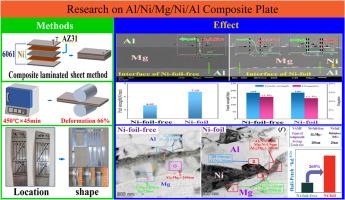镍箔对镁铝复合材料界面结构和性能的控制机理
IF 13.8
1区 材料科学
Q1 METALLURGY & METALLURGICAL ENGINEERING
引用次数: 0
摘要
研究了6061/AZ31B/6061复合材料中有无Ni箔夹层的界面力学性能和结构演化机制。对于无ni界面,形成连续扩散层(3.5-4.0µm),以脆性柱状Al₁₂Mg₁₇金属间化合物(IMCs,厚度0.27-0.35µm)为主,是首选裂纹起裂部位。相反,在热轧过程中,Ni箔的注入引起界面重构:约束变形使Ni箔破碎成具有“橄榄”形截面的网格状片段,嵌入Mg/Al基体中。这些碎片(56%的面积覆盖率)与碎片边缘分散的多相IMCs (Mg₂Ni, Al₃Ni, Mg₃AlNi, Al₁₂Mg₁₇;10-20 nm颗粒)共存,形成了“柳树叶”Al₁₂Mg₁₇岛和纳米级Mg₂Ni/Al₃Ni层(15-25 nm)的混合界面。Hall-Petch分析显示,多相IMC界面的“kd⁻¹/²”强化贡献比单相Al₁₂Mg₁₇系统高3.6倍,这归因于晶粒细化(20 nm对260 nm的平均晶粒尺寸)。机械联锁、粘附层次(Ni-Al > Ni-Mg >Al-Mg)和纳米级增强的协同效应,在不影响整体拉伸性能的情况下,共同提高了78%的剥离强度。本文章由计算机程序翻译,如有差异,请以英文原文为准。

Control mechanism of Ni-foil on the interfacial structure and properties of the magnesium alumina laminated composite plate
The paper study the interfacial mechanical properties and structural evolution mechanisms in 6061/AZ31B/6061 composite plates with and without Ni foil interlayers. For Ni-free interfaces, a continuous diffusion layer (3.5–4.0 µm) forms, dominated by brittle columnar Al₁₂Mg₁₇ intermetallic compounds (IMCs, 0.27–0.35 µm thick), which act as preferential crack initiation sites. In contrast, Ni foil implantation induces interfacial restructuring during hot rolling: Constrained deformation fragments the Ni foil into grid-like segments with "olive"-shaped cross-sections, embedded into Mg/Al matrices. These fragments (56% areal coverage) coexist with dispersed multiphase IMCs (Mg₂Ni, Al₃Ni, Mg₃AlNi, Al₁₂Mg₁₇; 10–20 nm grains) at fragment edges, forming a hybrid interface of "willow-leaf" Al₁₂Mg₁₇ islands and nanoscale Mg₂Ni/Al₃Ni layers (15–25 nm). Hall-Petch analysis reveals the multiphase IMC interface exhibits 3.6 × higher "kd⁻¹/²" strengthening contribution than single-phase Al₁₂Mg₁₇ systems, attributed to grain refinement (20 nm vs. 260 nm average grain size). Synergistic effects of mechanical interlocking, adhesion hierarchy (Ni-Al > Ni-Mg >Al-Mg), and nanoscale reinforcement collectively enhance peel strength by 78% without compromising bulk tensile properties.
求助全文
通过发布文献求助,成功后即可免费获取论文全文。
去求助
来源期刊

Journal of Magnesium and Alloys
Engineering-Mechanics of Materials
CiteScore
20.20
自引率
14.80%
发文量
52
审稿时长
59 days
期刊介绍:
The Journal of Magnesium and Alloys serves as a global platform for both theoretical and experimental studies in magnesium science and engineering. It welcomes submissions investigating various scientific and engineering factors impacting the metallurgy, processing, microstructure, properties, and applications of magnesium and alloys. The journal covers all aspects of magnesium and alloy research, including raw materials, alloy casting, extrusion and deformation, corrosion and surface treatment, joining and machining, simulation and modeling, microstructure evolution and mechanical properties, new alloy development, magnesium-based composites, bio-materials and energy materials, applications, and recycling.
 求助内容:
求助内容: 应助结果提醒方式:
应助结果提醒方式:


